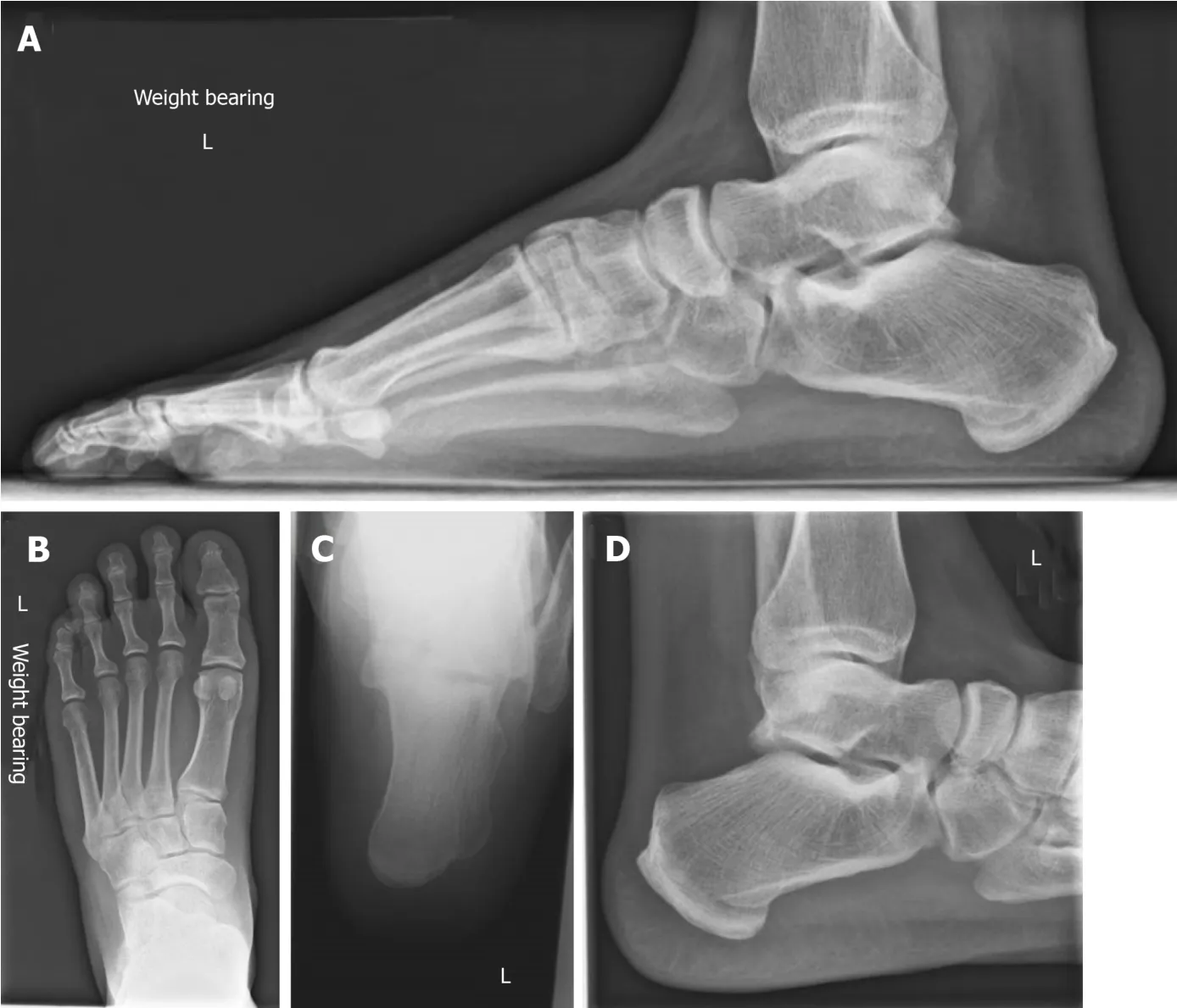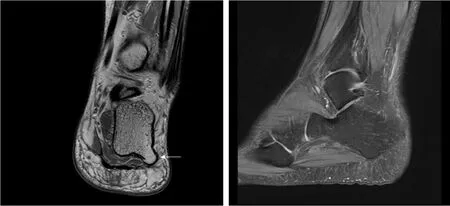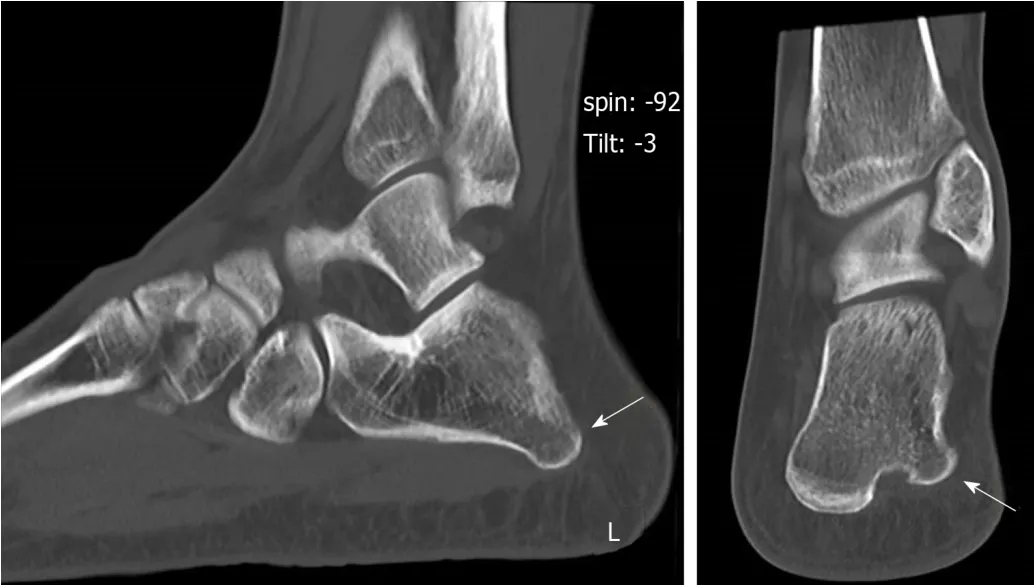Calcaneal osteochondroma masquerading as plantar fasciitis: An approach to plantar heel pain - A case report and literature review
2019-11-12DonKohYvonneGohNicholasYeo
Don Koh, Yvonne Goh, Nicholas Yeo
Abstract
Key words: Chronic heel pain; Recalcitrant heel pain; Osteochondroma; Diagnostic challenge; Case report
INTRODUCTION
Heel pain is a common orthopaedic complaint, constituting about 15% of foot pain[1].1 in 8 people aged 50 years and older complain of heel pain, with more than half reporting that the severity is disabling[2].
The various aetiologies of heel pain can be broadly classified into mechanical,neurological, traumatic and degenerative causes with the most common cause being mechanical[3,4].Accurate diagnosis can be challenging, owing to the complex anatomy and their interdependent mechanical relationships as well as vulnerable pain generators present in the foot[5].Heel pain is best defined by the Heel Pain Committee of the American College of Foot and Ankle Surgeons as pain either over the posterior or plantar aspect of the foot[4].For the purpose of this article, focus will be on plantar heel pain.
As with all foot and ankle pathologies, a good grasp of anatomy, clinical acuity,detailed history taking as well as physical examination are key to achieving an accurate diagnosis.Astute application of investigative modalities aid in confirming the diagnosis.Conversely, inappropriate treatment can lead to worsening or chronic pain that can result in morbidity[2].In this case report, we aim to share our clinical experience in managing one such patient whose plantar heel pain was refractory to all treatment modalities offered.We present an unusual case of chronic heel pain secondary to osteochondroma.
CASE DESCRIPTION
Chief complaints
A 41-year-old Malay gentleman who works as a hospital porter presented with a long-standing history of left plantar heel pain.
History of present illness
His gastrocnemius was also noted to be tight with positive Silfverskiöld test.He was treated for plantar fasciitis and tight gastrocnemius and underwent extensive physiotherapy sessions targeted at gastrocnemius stretching.He was started on antiinflammatory and analgesic medications.However, his symptoms persisted, and he underwent left gastrocnemius release and endoscopic plantar fascia release.This provided temporal relief of his symptoms, and he was able to return to work.
Two and half years later, he presented with similar symptoms of left heel pain.His gastrocnemius was once again assessed to be tight demonstrating limited dorsiflexion in the absence of ankle osteoarthritis.A repeated minimally invasive gastrocnemius release was performed.He underwent a prolonged recovery with enforced rest and time off work, which improved his symptoms.However, his symptoms quickly reoccurred upon return to work.
History of past illness
He is obese (BMI:31 kg/m2), has hyperlipidaemia but reports no history of diabetes or gout.
Physical examination
Patient ambulated with an antalgic gait.On physical assessment, his gastrocnemius remained tight with a positive Silfverskiöld test.Tenderness around the plantar aspect of the calcaneum was non-specific and found along the distribution of the plantar fascia insertion.
Imaging examinations
Foot and calcaneal radiographs showed normal bony relationships of the foot with no features of arthritis (Figure 1).No fractures or obvious lesions were noted.Magnetic resonance imaging (MRI) of the left foot was performed.It reported the absence of plantar fascia thickening as well as no signal alteration in the adjacent soft tissue or bone marrow.MRI did reveal a pedunculated bony protrusion arising from the posterolateral plantar aspect of the calcaneus measuring 1.1 cm × 0.9 cm, which was consistent with an osteochondroma (Figure 2).Computed tomography scan was organised to better evaluate this lesion (Figure 3).
FINAL DIAGNOSIS
Osteochondroma of the calcaneum with a concomitant gastrocnemius contracture.
TREATMENT
Decision for surgical excision of left calcaneal lesion was made in view of chronic discomfort and limited relief from two other previous procedures.A mini-incision was made centred over the posterolateral border of calcaneum.A soft tissue flap was raised allowing access to the lesion.The bony lesion was exciseden blocand sent for histological analysis.Layered closure was attempted and wound dressed with Jones dressing.Patient was kept on non-weight bearing over the left lower limb before progressing to full weight bearing once the wound healed.Histology reported the lesions as a nodular lesion with mature lamellar bone consistent with a matured osteochondroma.
OUTCOME AND FOLLOW UP
The patient was followed up closely and remains pain-free 12 mo after surgery.He is back to work and very satisfied with the surgery.
DISCUSSION
Plantar fasciitis
This patient presented with typical signs and symptoms of plantar fasciitis, a common cause of heel pain especially amongst middle-aged patients[6].Plantar fasciitis is a condition attributed to biomechanical stress of the plantar fascia and its calcaneal insertion.Risk factors of developing plantar fasciitis involve those subjecting the plantar fascia to excessive biomechanical stress.Being obese is a well-documented risk factor[7-9].Abnormal strain on the windlass mechanism of the foot results in excessive plantar fascia tendon loading and subsequent injury[10].In non-athletic individuals,patients with BMI ≥ 27 kg/m2are 3.7 times more likely to suffer from plantar heel pain[7].In addition, this patient had a tight gastrocnemius[8]as well as a job requiring excessive push-off force to manually transport heavy carts, patients and machines around the hospital.Tight gastrocnemius limits ankle dorsiflexion, thereby producing increased strain on the plantar fascia during the gait cycle[11-13].Pes cavus is another anatomical risk factor.Patients who have pes cavus have a reduced distance between the calcaneus and the metatarsal heads and rigid relationships between both bony and soft tissue structures[14].
The initial management for plantar fasciitis is conservative.In keeping with the literature, this patient was started on a course of plantar fascia as well as gastrocnemius stretching with a physiotherapist[11,15].DiGiovanniet al[16,17]demonstrated significant pain relief after 8 wk of plantar fascia specific stretches as compared to gastrocnemius stretches alone.Coupled with the use of noninflammatory and analgesia medications, off-loading orthotics, heel cups and adequate rest, these treatments form the backbone of plantar fasciitis management[4,5,18].

Figure 1 Foot and calcaneal radiographs.
However, our patient remained symptomatic after a year of conservative management and decided to undergo endoscopic plantar fasciotomy and gastrocnemius release.This surgery offered significant relief in the acute setting.Plantar fasciotomy is the technique of choice in recalcitrant plantar fasciitis[19-22].In a survey of 64 patients who underwent plantar fasciotomy, Wheeleret al[22]reported 84% of patients were satisfied or very satisfied, with almost three quarters of patients experiencing greater than 80% pain relief.However, owing to varying techniques described within the literature (namely open, mini-open and endoscopic ablation),there remains a paucity of good quality evidence supporting its role[21].Most agree with the use of the medial open approach releasing the medial third of the plantar fascia[23,24], although there is a growing number of studies showing comparable results using endoscopic plantar fasciotomy[5,25].
Proximal medial gastrocnemius release in the treatment of refractory plantar fasciitis has also shown excellent results without the complications associated with plantar fasciotomy[20,24,26].This technique was conceived after DiGiovanniet al[27]reported plantar foot pain associated with gastrocnemius contracture and Barouket al[24]demonstrated the safe surgical technique most authors now perform.
However, results can be unpredictable, especially in patients with chronic heel pain[28].Our patient returned complaining of similar symptoms after two and half years.The use of advanced imaging modalities, such as ultrasound and MRI is not necessary in diagnosing plantar fasciitis.Toomeyet al[29]demonstrated poor correlation between plantar fascia thickness and plantar heel pain.Therefore, most authors believe that plantar fasciitis is a clinical diagnosis[5,24,29,30].In the case above however, recalcitrant heel pain despite surgical intervention is a red flag warranting further investigation[4,5].In addition, should the tenderness not be localised to the plantar fascia insertion or if the clinical picture appears inconsistent, then advanced imaging would be prudent.
Diagnosing recalcitrant plantar heel pain
In a diagnostically challenging case, astute clinical reasoning is key.Most heel pain arises from soft tissue structures such as tendons, fascia and nerves around the calcaneus and less commonly from bone and apophyses[3].Plantar foot pain pathologies are often mechanical in nature[31].
The authors propose key considerations when approaching heel pain (Table 1).Location, age, precipitating events and nature of symptoms are all important clues to deriving an accurate diagnosis.Pinpointing the location of greatest discomfort is the most useful way of arriving at a diagnosis; it narrows potential differentials and focuses history taking and clinical examination towards structures underlying the site[30].Patients are encouraged to point a finger at the location of greatest discomfort and through the application of clinical anatomy enquire about exacerbating factors as well as perform respective provocation manoeuvres (Table 1).

Figure 2 Magnetic resonance imaging of foot.
Age is another useful tool in diagnosing heel pain.Almost a quarter of the population aged 45 years and older suffer from foot pain[32].In the middle aged and elderly, osteoarthritis and tendinopathies as well as plantar fasciitis are more common[24,33,34].Scheret al[35]reported increasing incidence of plantar fasciitis with increasing age of United States military service members suggesting that the loss of heel-pad elasticity and its ability to “shock-absorb” results in excessive strain to the plantar fascia.Whereas, in the younger, active populations, traumatic or repetitive stress injuries are more likely[36-38].
In the absence of trauma or a fall, bony injury is less likely.Pain that worsens with activity and pushing off suggests a mechanical origin.However, in a patient with chronic heel pain not improved by surgery, sinister causes such as malignancy or infection need to be excluded.Other considerations include a neurological cause from radicular symptoms, referred pain or even systemic inflammatory pathologies (Table 1).
Bilateral dorsoplantar and lateral weight-bearing foot radiographs are fundamental investigations when assessing foot pain.It offers insight into the foot’s bony relationships and allows comparison with the contralateral limb (Figure 1A).Dedicated calcaneal radiographs provide an unobstructed axial view, commonly obscured by overlapping structures of the foot.The presence of osteochondroma on calcaneal radiographs was not obvious on either foot (Figure 1).
In patients with recalcitrant pain refractory to surgery, advanced imaging, such as MRI or computed tomography scans is indicated to evaluate other causes of pain.MRI would allow better assessment of soft tissue pathology as well as acute bony injury after trauma (Figure 2).On the other hand, computed tomography scans provide good bony definition (Figure 3).
Calcaneal osteochondroma
Osteochondromas are the most common benign tumour of the skeleton accounting for 36% to 41% of benign bone tumours[39-41]and affecting about 2% to 3% of the general population[41-43].However, its presentation in a foot and ankle account for less than 10% of such cases[42-46].Osteochondromas are benign osseous lesions that originate from the metaphyseal regions of long bones and on histology classically present with normal bony trabeculae with a distinct hyaline cartilage cap[41,42,44].Most osteochondromas are usually asymptomatic and are incidentally picked up on radiographs[42].They are commonly found in adolescents and young adults presenting often as a painless mass, but it can be symptomatic as a sequelae of its size causing entrapment of neurovascular structures, restriction of movement and fractures[42,44].Malignant transformation is rare accounting for less than 1% of osteochondromas[41,47,48].Its presentation in a skeletally mature adult is rare.To date,only a handful of case reports are found in the literature[42,45,46].
CONCLUSION
There are many causes of heel pain, with plantar fasciitis being the most common cause.However, in recalcitrant heel pain refractory to both conservative and surgical management, it would be astute to investigate the underlying cause further.Osteochondroma of the calcaneum is uncommon but a potential cause of debilitating plantar heel pain.Surgical excision can improve symptoms and reduce plantar heel pain.

Figure 3 Computed tomography of foot showing a pedunculated bony protuberance at the lateral border without periosteal reaction nor bony destruction.
